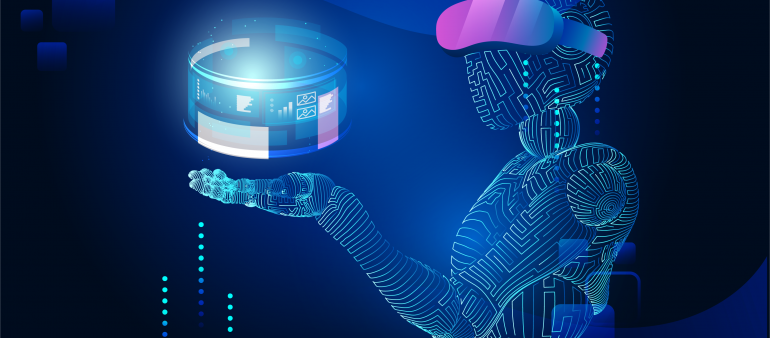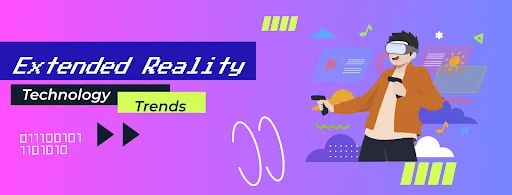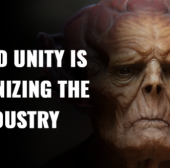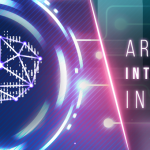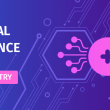The world of technology is constantly evolving, and two of the most buzzworthy trends in recent years have been Extended Reality (XR) and Artificial Intelligence (AI). These technologies have the potential to be powerful allies when combined.
XR has a wide range of applications, from gaming and entertainment to education and training. It has the potential to revolutionize how we interact with digital content and could change the way we work, learn, play, and live.
The Extended Reality (XR) Market is growing at a CAGR of 57.91% according to a report by Mordor Intelligence.
AI has the potential to transform a wide range of industries, from healthcare and transportation to finance and retail. It can help businesses process large amounts of data more efficiently, make better-informed decisions, and improve customer service.
As per McKinsey Global Survey on AI, 2022, 60 percent of respondents expect their organizations to increase their investment in AI over the next three years.
Exploring the Transformative Power of Combining XR and AI
As XR and AI continue to evolve, it will be important for businesses and individuals to stay up-to-date on these technologies and how they can be used to improve their lives and work. With the right tools and strategies, XR and AI have the power to drive innovation, boost productivity, and create more meaningful and engaging experiences.
Here are just a few examples of how these technologies can work together to create powerful experiences:
Virtual Assistants:
AI-powered virtual assistants, such as Amazon's Alexa and Apple's Siri, have become increasingly popular in recent years. By using XR technology, these assistants could potentially become even more lifelike and engaging. Imagine being able to see and interact with your virtual assistant in a fully immersive digital environment, rather than just hearing their voice. This could make the experience of using a virtual assistant feel more natural and personal.
Gaming:
Many game development companies are booming with the implementation of AI and XR due to the increased realism and immersion that these technologies provide. AI and XR allow for more complex and dynamic game worlds, as well as more realistic and responsive characters. Imagine being able to fully explore and interact with virtual worlds that are just as detailed and realistic as the real world. For example, the AI-driven NPC (non-player characters) in the game can have their own behaviors and motivations, making them feel more like real characters.
The advent of machine learning has made it possible to create new genres of games and experiences that were previously impossible. Machine learning algorithms allow for the creation of more sophisticated and dynamic systems and interactions within games, which can lead to the development of entirely new types of gameplay and experiences.
The World Economic Forum's report on "The Future of Jobs and Skills" predicts that the demand for AI and XR skills in the gaming industry will grow significantly in the coming years. A similar report from the Global XR Nonprofit Network estimates that the global XR market (which includes gaming) will reach $80 billion by 2025.
XR and AI are not mere toys for gaming and entertainment but can also be used to create highly realistic training simulations for a wide range of industries, including healthcare, military, and aviation. By using AI to adapt to the user's actions and responses, these simulations can become even more immersive and effective.
Some examples,
Workspace:
XR and AI has the potential to transform the way we work. For example, XR could be used to create virtual coworking spaces where employees can meet and collaborate in a fully immersive digital environment. AI could be used to automate tasks and make the workplace more efficient. This technology has gained popularity, particularly to facilitate social distancing, and work-from-home transition.
Medical Simulation:
XR can be used to create virtual reality therapies for a wide range of conditions, from anxiety and depression to chronic pain and post-traumatic stress disorder. AI can be used to analyze large amounts of medical data and help doctors make more accurate diagnoses and treatment recommendations.
A surgeon could practice a complex procedure in a VR simulation that challenges them with unexpected complications, helped by AI-powered feedback and guidance.
Smart Pedagogy:
The global lockdown due to COVID-19 pandemic highlighted the importance of technology in education and the need for remote learning options. XR and AI can play a significant role in meeting these needs by providing students with virtual lab simulations and personalized learning experiences. AI can help create tailored educational experiences that adapt to each student's needs and abilities, making education more effective and efficient. AI could also be used to provide feedback and guidance to help students understand the underlying principles and concepts.
AI-powered Precision Farming:
AI and XR have the potential to optimize agriculture operations helping farmers to grow more healthy and sustainable crops. AI could be used to analyze the data and suggest the most efficient planting and harvesting patterns, as well as the best locations for irrigation and other infrastructure, while XR can create training simulations for farmers. Using sensors and cameras, AR can monitor soil conditions, and crops for signs of pests or diseases.
Predictive Policing:
AI algorithms can analyze past crime data to identify patterns and trends, while XR technology can visualize the data for law enforcement. XR can also create training simulations for law enforcement personnel and VR therapy programs for offenders. AR can aid in crime scene investigations by gathering and analyzing data, with AI providing insights and recommendations. The combination of AI and XR can reduce crime rates and improve public safety.
As per a report by Mordor Intelligence, “The Threat Intelligence Security Services Market was valued at USD 1863.48 million in 2020 and is expected to reach USD 3829.77 million by 2026, at a CAGR of 12.9% over the forecast period 2021 - 2026.”
The Future of XR and AI
While XR and AI have already shown tremendous potential when combined, we are still in the early stages of what these technologies can do. As they continue to evolve and become more sophisticated, the possibilities are almost endless.
Take a look at some of the very interesting data sourced from https://www.statista.com
-
- Revenue in the AR & VR market is projected to reach US$31.12bn in 2023.
-
- Revenue is expected to show an annual growth rate (CAGR 2023-2027) of 13.72%, resulting in a projected market volume of US$52.05bn by 2027.
-
- The market's largest segment is AR Software with a market volume of US$11.58bn in 2023.
-
- With a projected market volume of US$8,568.00m in 2023, most revenue is generated in the United States.
-
- In the AR & VR market, the number of users is expected to amount to 2,593.1m users by 2027.
-
- User penetration will be 28.8% in 2023 and is expected to hit 32.6% by 2027.
-
- The average revenue per user (ARPU) is expected to amount to US$14.08.
-
- Revenue values displayed here only account for B2C revenues. Meaning, according to the displayed market share of B2C, 0.0% of the total market (B2C & B2B) is covered.
There is already a multitude of XR and AI products and services available on the market, and this is just the beginning. As these technologies become more advanced and accessible, we can expect to see even more innovative and exciting applications emerge.
As with any new technology, there are also concerns about the potential impact of XR and AI on privacy and security. It will be important for businesses and individuals to carefully consider these issues as these technologies continue to develop and become more widespread.
In conclusion, as the world becomes increasingly digital, the demand for XR and AI technologies will only continue to grow. In fact, the global market for XR is projected to reach over $160 billion by 2023, while the global AI market is expected to reach over $190 billion by 2025.
 Get a Quote
Get a Quote

